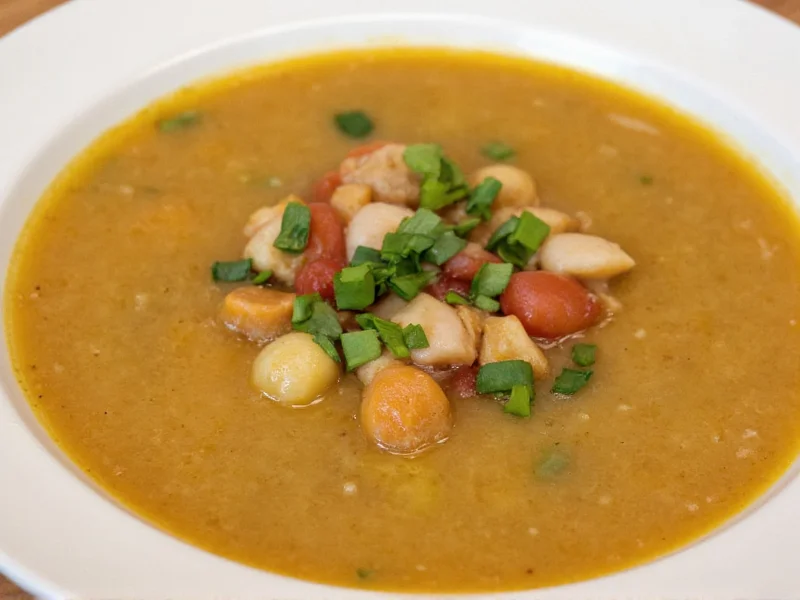Understanding what qualifies as soup goes beyond the simple dictionary explanation. This comprehensive guide explores the culinary definition, historical context, and key characteristics that define this universal food preparation method enjoyed across cultures for thousands of years.
What Makes Something a Soup: The Culinary Definition
While dictionaries provide basic soup meaning in culinary terms, professional chefs and food historians recognize more nuanced criteria. Soup fundamentally consists of four essential elements:
| Element | Description | Required Amount |
|---|---|---|
| Liquid Base | Stock, broth, water, or other liquid | Minimum 60% of total volume |
| Solids | Meat, vegetables, grains, or other ingredients | 30-40% of total volume |
| Seasoning | Herbs, spices, salt, acids | To taste |
| Thickening Agent | Roux, puree, starch, or cream (optional) | As needed for desired consistency |
The precise soup definition varies slightly depending on culinary tradition. In French cuisine, for example, soup must be passed through a sieve for certain preparations, while Asian soup definitions often emphasize the balance of flavors rather than texture.
Historical Evolution of Soup
The concept of soup dates back to prehistoric times when early humans discovered that boiling ingredients in water created more digestible and flavorful food. Archaeological evidence suggests that soup-making began approximately 20,000 years ago with the development of waterproof containers that could withstand fire.
Throughout history, the soup meaning in culinary terms has evolved:
- Ancient civilizations: Simple broths made from available ingredients
- Medieval Europe: Pottages and porridges that cooked for days
- 17th-18th century: Formalization of French soup techniques
- 19th century: Canned soups and commercial production
- Modern era: Global fusion and specialized soup categories
Soup vs. Similar Dishes: Understanding the Differences
Many people wonder about the difference between soup and stew or soup vs broth definition. The distinctions lie primarily in liquid content, cooking method, and ingredient proportions:
- Soup vs. Stew: Soups contain more liquid (typically 60% or more) and ingredients are usually cut smaller. Stews have less liquid that mostly gets absorbed during longer cooking.
- Soup vs. Broth: Broth is a type of soup that's typically clear and made from simmering meat or vegetables. All broths are soups, but not all soups are broths.
- Soup vs. Chowder: Chowder is a specific type of thick soup, traditionally made with seafood or corn, often containing potatoes and cream.
- Soup vs. Bisque: Bisque is a smooth, creamy soup made from pureed vegetables or shellfish, often thickened with rice.
Major Categories of Soup
Culinary professionals classify soups into several main categories based on preparation method and ingredients:
- Clear Soups: Broths and consommés where the liquid remains transparent
- Thick Soups: Purees, cream soups, and those thickened with roux or starch
- Specialty Soups: Bisques, chowders, and international variations
- Cold Soups: Gazpacho, vichyssoise, and other chilled preparations
Each category follows the basic soup definition while incorporating specific preparation techniques that distinguish them from one another. For example, a proper consommé requires clarification to achieve its characteristic transparency, while a chowder must contain specific ingredients like potatoes and cream to qualify as such.
Cultural Variations in Soup Definition
The soup meaning in culinary terms varies across cultures, reflecting local ingredients and traditions:
- Asian traditions: Often emphasize broth quality and balance of five flavors
- Mediterranean approaches: Feature vegetable-heavy soups like minestrone
- Eastern European styles: Known for hearty, meat-based soups like borscht
- Latin American varieties: Incorporate beans, corn, and chili peppers prominently
Despite these variations, all cultural interpretations maintain the fundamental characteristic of soup: a liquid-based preparation that serves as either a starter or complete meal.
Modern Interpretations of Soup
Contemporary chefs continue to expand the traditional soup definition while maintaining its essential characteristics. Molecular gastronomy has introduced foam-based "soups," while health trends have popularized bone broth variations. However, for a preparation to qualify as soup in culinary terms, it must still maintain that essential liquid component that defines the category.
Understanding the precise soup definition helps home cooks and professional chefs alike create authentic preparations that honor culinary traditions while allowing for creative interpretation. Whether you're making a simple chicken noodle soup or an elaborate French bisque, recognizing what makes something a soup ensures your preparation aligns with established culinary standards.
What is the basic definition of soup?
Soup is a primarily liquid food made by combining ingredients like meat, vegetables, or legumes with stock, juice, water, or another liquid base. By culinary standards, soup must contain at least 60% liquid by volume, distinguishing it from similar dishes like stews which have less liquid content.
How is soup different from stew?
The primary difference between soup and stew lies in liquid content and cooking method. Soup contains more liquid (typically 60% or more of total volume) and ingredients are usually cut smaller. Stews have less liquid that mostly gets absorbed during longer cooking times, resulting in a thicker consistency where ingredients maintain their shape more distinctly.
Is broth considered a soup?
Yes, broth is considered a type of soup. Specifically, broth is a clear soup made by simmering meat, bones, or vegetables in water. All broths qualify as soups, but not all soups are broths, as soups can include thickened varieties, purees, and cream-based preparations that don't qualify as broths.
What are the essential components of soup?
The essential components of soup include: a liquid base (minimum 60% of total volume), solid ingredients (30-40% of volume such as meat or vegetables), seasoning (herbs, spices, salt), and optionally a thickening agent. These elements combine to create the characteristic texture and flavor profile that defines soup in culinary terms.
Can soup be served cold?
Yes, soup can be served cold and still meet the standard soup definition. Examples include gazpacho from Spain, vichyssoise from France, and certain Scandinavian fruit soups. The defining characteristic of soup is its liquid base composition, not its serving temperature, though most traditional soups are served warm or hot.











 浙公网安备
33010002000092号
浙公网安备
33010002000092号 浙B2-20120091-4
浙B2-20120091-4